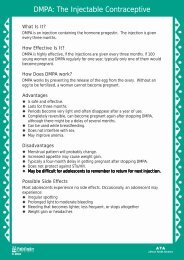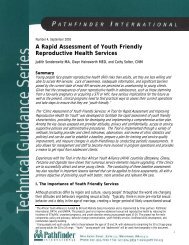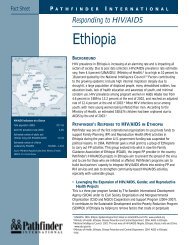Management Information Systems - Pathfinder International
Management Information Systems - Pathfinder International
Management Information Systems - Pathfinder International
Create successful ePaper yourself
Turn your PDF publications into a flip-book with our unique Google optimized e-Paper software.
The following table provides a systematic way of reviewing how a well-designed MIS functionsat every level. The table can serve as a checklist for managers and consultants in creating,institutionalizing, or revising an MIS.MIS Step by Step...Stages What to Do Output1. AssessmentThis stage helps you to: identify ☛ Systematically meet with ☛ <strong>Information</strong> needs, e.gall the staff who will use staff colleagues, community number of new users,information; assess objectives leaders, clients to solicit number of items for saleof organization; select required their inputs. produced daily, etc.information: determine formats systematically ☛ New forms or improvedfor information collection; ☛ Analyse the results formats designed .establish the manual or guide of your needs assessment. ☛ Formats used atto support the system; anddifferent levelstrain staff.confirmed.2. Data Collection20At this stage, the manager ☛ Develop formats for ☛ Regular information ondetermines the frequency of information required users/clients volumes ofinformation collection. frequently. sales income andFrequency may vary, e.g., new ☛ Monitor data collection. expenditure,users/clients, financial ☛ Support the use of other activities available.information collected methods to collect ☛ Supplementary informationregularly and daily, while supplementary informa- to support regularIEC material distributed tion periodically. information, e.g., marketmay be monthly or quarterly.survey, quality of service,channels of distribution.Supplementary information☛ Data available in records,e.g., rapid assessment (smallregisters, forms.scale survey), focus group☛ Daily, weekly, monthly,discussion (FGD) smallquarterly and annualoperations research shouldsummary sheets or tables.also be identified.3. Data CollationAt this stage the manager ☛ Compile data from registers, ☛ Records, registers, and formsdetermines how data can be records and forms into from clinics, service centers,summarized to facilitate summary of collation sales outlets, financecomprehensive review and sheets. department.decision-making. ☛ Establish a way ofsummarizingthe data regularly (e.g.,daily, weekly, monthly,quarterly, annually).☛ Cross-check data;transfer from client, salesrecords to the summarysheet and ensureaccuracy.☛ Establish a way to storethe client, sales, financerecords in theorganization.
















